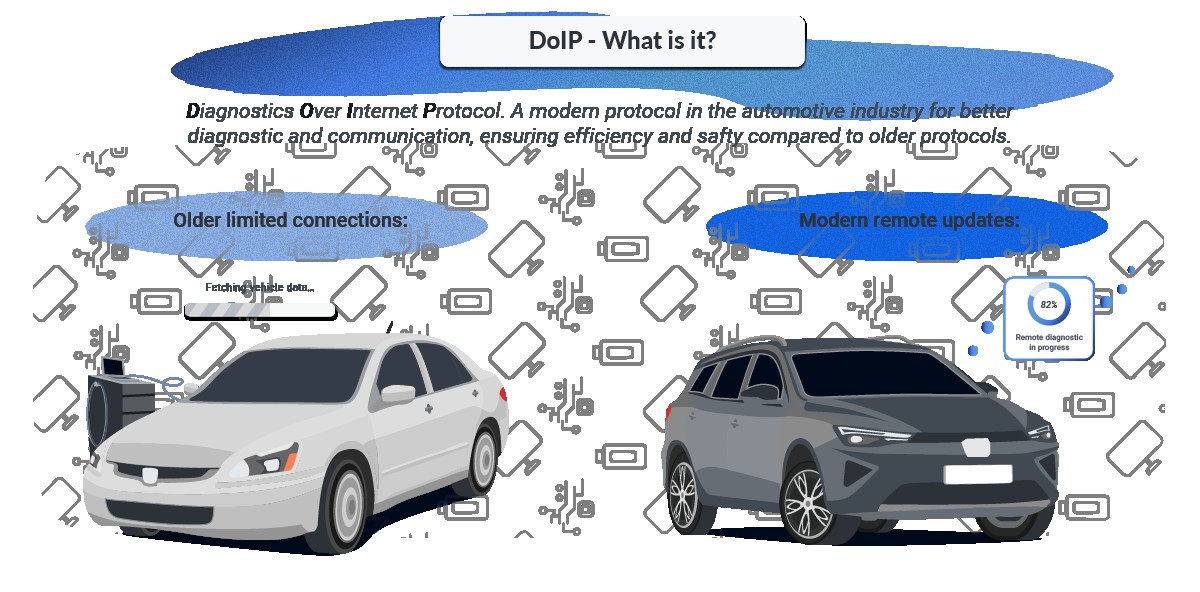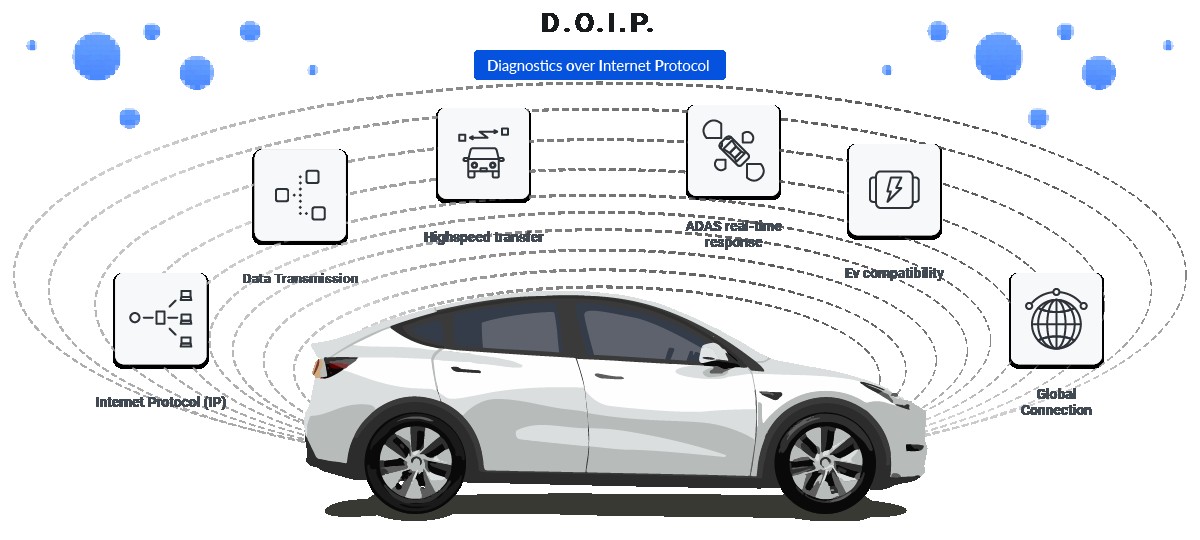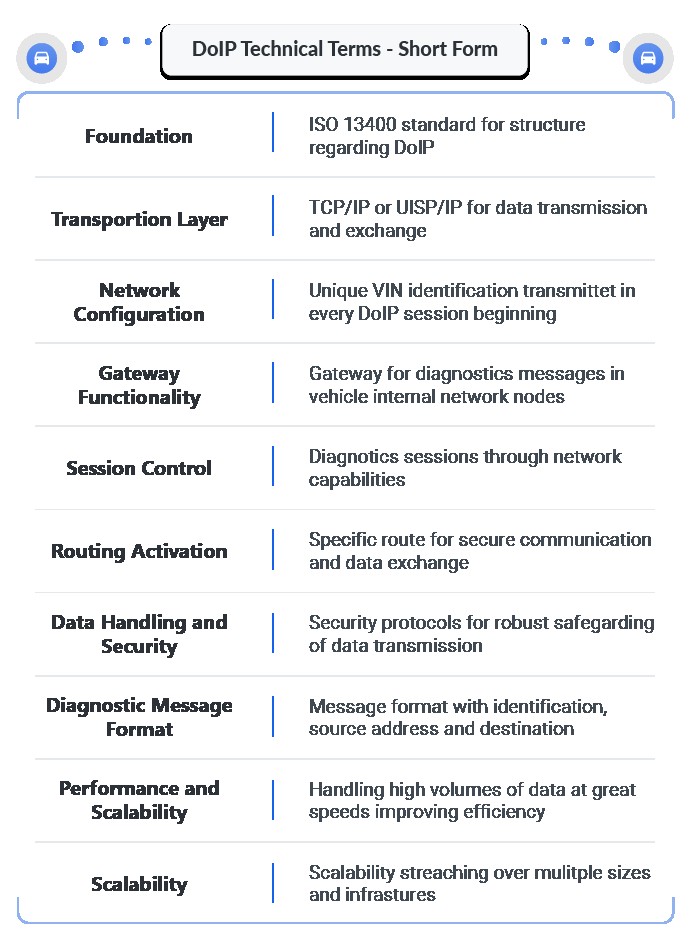DoIP, or Diagnostic over Internet Protocol, is a crucial communication protocol revolutionizing automotive diagnostics. This article delves into the meaning of DoIP, its technical specifications, applications, benefits, and how it compares to traditional diagnostic methods. Understanding DoIP is essential for anyone involved in the automotive industry, from manufacturers and mechanics to technology enthusiasts.
Defining DoIP: The Future of Vehicle Diagnostics
DoIP leverages standard internet protocols to enable faster and more efficient communication between diagnostic tools and vehicle systems. Unlike older methods relying on direct physical connections, DoIP allows for remote diagnostics and software updates via Ethernet networks. This capability is paramount in today’s increasingly complex and connected vehicles. DoIP emerged as a solution to the limitations of traditional diagnostic systems, offering broader reach and higher speeds for data transmission.
Technical Specifications of DoIP: A Deep Dive
DoIP adheres to the ISO 13400 standard, ensuring compatibility and interoperability across different systems. It utilizes TCP/IP and UDP/IP for reliable data transfer, enabling high-speed communication between diagnostic equipment and vehicles. This framework supports faster diagnostics, comprehensive data analysis, and efficient management of modern vehicle technologies like Advanced Driver-Assistance Systems (ADAS) and Electric Vehicles (EVs). Key specifications include:
- Protocol Basis: Built upon the Internet Protocol (IP) for universal network compatibility.
- ISO Standard: Conforms to ISO 13400, ensuring standardized data transmission and security.
- Data Transfer: Facilitates high-speed data transfer for rapid diagnostics and software updates.
DoIP Applications: Transforming Automotive Practices
DoIP is reshaping vehicle servicing and maintenance, enabling remote troubleshooting and streamlined updates. Real-time diagnostics, over-the-air software updates, and enhanced manufacturing quality control are just a few of its transformative applications. DoIP empowers technicians to diagnose issues remotely, minimizing vehicle downtime and optimizing service efficiency.
Benefits of DoIP: Efficiency, Scalability, and Cost-Effectiveness
DoIP offers significant advantages over traditional methods:
- Enhanced Efficiency: Streamlines diagnostics and updates, reducing service times.
- Scalability: Adaptable to various environments, from small workshops to large-scale manufacturing facilities.
- Cost-Effectiveness: Minimizes reliance on physical tools and manual interventions, lowering operational costs.
These benefits contribute to improved workflow, reduced downtime, and enhanced service quality across the automotive industry.
DoIP vs. Traditional Protocols: A Comparative Analysis
| Feature | DoIP | Traditional Protocols |
|---|---|---|
| Network Integration | Utilizes IP networks (Ethernet, Wi-Fi) | Relies on direct connections (CAN, K-Line) |
| Data Transfer Speed | High-speed transmission | Limited by slower transmission rates |
| System Compatibility | Seamless integration with modern systems | Potential compatibility issues with new systems |
| Scalability | Easily adaptable to different scales | Less flexible and costly to scale up |
| Operational Cost | Lower operational costs | Higher costs due to manual processes |



DoIP’s superior performance, scalability, and cost-effectiveness make it the preferred choice for modern vehicle diagnostics.
Core Technical Aspects of DoIP: Protocol Basics and Network Configuration
DoIP operates on the ISO 13400 standard, utilizing TCP/IP or UDP/IP for reliable data exchange. It employs unique Vehicle Identification Numbers (VINs) for vehicle identification and secure routing activation for protected communication. Robust encryption and authentication protocols safeguard data transmission, ensuring diagnostic accuracy and security. DoIP’s high-speed data transfer capabilities and scalability further enhance its effectiveness in diverse automotive environments.
Conclusion: DoIP’s Impact on the Automotive Landscape
DoIP signifies a paradigm shift in automotive diagnostics. Its ability to leverage internet protocols for faster, more efficient communication transforms how vehicles are serviced and maintained. As vehicles continue to evolve in complexity, DoIP’s advanced capabilities will play an increasingly critical role in ensuring optimal performance, safety, and reliability. DoIP is not just a technological advancement; it’s the foundation for the future of automotive diagnostics.
